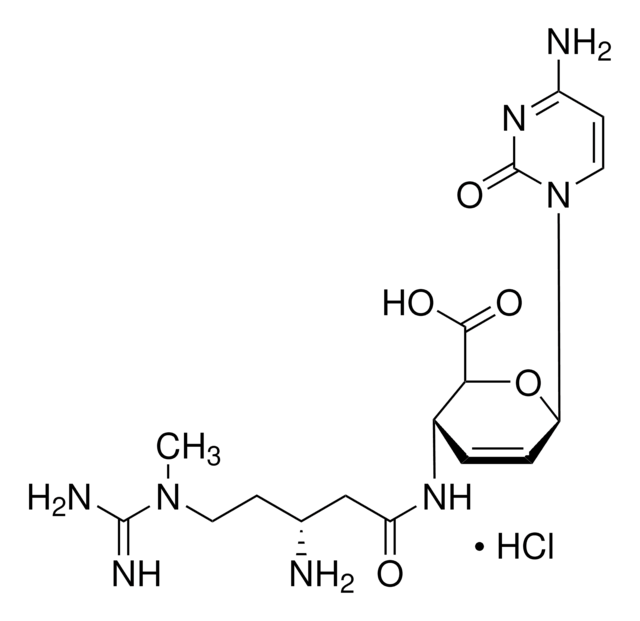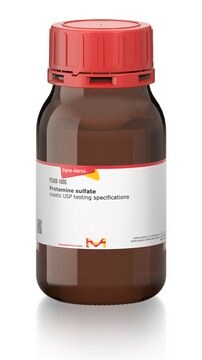540411
Puromycin, Dihydrochloride, Cell Culture-Tested
Puromycin, CAS 58-58-2, is a protein synthesis inhibitor that causes premature release of nascent polypeptide chains.
Synonim(y):
Puromycin, Dihydrochloride, Cell Culture-Tested
About This Item
Polecane produkty
Poziom jakości
Próba
≥98% (HPLC)
Postać
solid
producent / nazwa handlowa
Calbiochem®
warunki przechowywania
OK to freeze
desiccated
zanieczyszczenia
≤10 EU/mg Endotoxin (dry weight)
kolor
white to off-white
rozpuszczalność
methanol: 20 mg/mL
water: 50 mg/mL
Warunki transportu
ambient
temp. przechowywania
−20°C
InChI
1S/C22H29N7O5.2ClH/c1-28(2)19-17-20(25-10-24-19)29(11-26-17)22-18(31)16(15(9-30)34-22)27-21(32)14(23)8-12-4-6-13(33-3)7-5-12;;/h4-7,10-11,14-16,18,22,30-31H,8-9,23H2,1-3H3,(H,27,32);2*1H/t14-,15+,16?,18+,22+;;/m0../s1
Klucz InChI
MKSVFGKWZLUTTO-USYAMCSGSA-N
Opis ogólny
Działania biochem./fizjol.
protein synthesis
Ostrzeżenie
Rekonstytucja
Inne uwagi
Kaufman, S.H., et al. 1993. Cancer Res.53, 3976.
de la Luna, S. and Ortín, J. 1992. Methods Enzymol.216, 376.
Chow, S.C., et al. 1991. Exp. Cell Res. 216, 149.
Informacje prawne
Hasło ostrzegawcze
Warning
Zwroty wskazujące rodzaj zagrożenia
Zwroty wskazujące środki ostrożności
Klasyfikacja zagrożeń
Acute Tox. 4 Oral
Kod klasy składowania
11 - Combustible Solids
Klasa zagrożenia wodnego (WGK)
WGK 3
Temperatura zapłonu (°F)
Not applicable
Temperatura zapłonu (°C)
Not applicable
Certyfikaty analizy (CoA)
Poszukaj Certyfikaty analizy (CoA), wpisując numer partii/serii produktów. Numery serii i partii można znaleźć na etykiecie produktu po słowach „seria” lub „partia”.
Masz już ten produkt?
Dokumenty związane z niedawno zakupionymi produktami zostały zamieszczone w Bibliotece dokumentów.
Klienci oglądali również te produkty
Nasz zespół naukowców ma doświadczenie we wszystkich obszarach badań, w tym w naukach przyrodniczych, materiałoznawstwie, syntezie chemicznej, chromatografii, analityce i wielu innych dziedzinach.
Skontaktuj się z zespołem ds. pomocy technicznej













